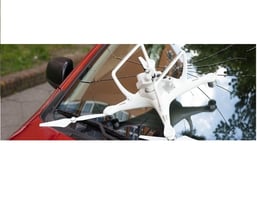Below we share the most common reasons for drone-related claims from our COVERDRONE customers in...
10 Tips for preventing Drone Crashes
Information supplied by coverdrone.com
When it comes to flying a drone, there are some factors that are inevitably out of your hands which could result in you crashing your drone. However, there are some factors that can be easily avoided. That’s if you are aware of them.
Below we have outlined ten tips on how to avoid a drone crash.
1. Check the weather conditions
The first thing to consider is the forecasted weather conditions when you fly. Drones have many intricate motors and sensitive electronics that need to be protected as best as they can against airborne moisture resulting from rain, fog and snow.
Ideally you want to fly on days with clear skies and good visibility, and conditions that are not wet and windy, as they can drastically reduce your visibility and make it more difficult for you to fly safely.
Colder temperatures can also greatly reduce the chemical activity in lithium batteries. This reduces flight times and can cause your batteries to become unstable, putting your drone at risk of falling out of the sky without warning.
If you intend on flying during the winter months, check out our top tips for flying your drone this winter blog.
2. Do your pre-flight checks
It’s important to get into the habit of regularly checking the condition of your drone thoroughly to ensure it’s in a fit condition to fly before you set off. Below we’ve provided a few pointers on things to look out for that are common causes of drone crashes:
- Check you have sufficient GPS signal
- Check your battery packs are secure and fully charged
- Check your compass is correctly tuned and does not require calibration
- Check there is no damage to any ports
- Check for any loose wires
- Check your rotors/propellers are in good condition and have not bent out of shape or become damaged
3. Use the right landing pad or surface for taking off and landing
You are most susceptible of crashing your drone at the point of take-off and landing. It’s therefore important that you choose a landing pad or surface that is:
- Dry to prevent moisture getting into the motors, sensors and electronics
- Clear of any dust or debris
- Flat and stable to allow your drone to calibrate effectively
4. Hover your drone before setting off
We also recommend hovering your drone a few metres from the ground for a few minutes during take-off to enable your battery to sufficiently warm up and allow you to check everything is in full working order before you commence your flight. This allows you to quickly and safely return your drone to the ground if you do identify an issue.
5. Make sure your batteries are fully charged
Always ensure your batteries are fully charged before take-off and wherever possible try to avoid flying with low or partially charged batteries. Whilst you may think you have enough power to complete your flight safely with a semi-charged battery, it always carries the increased risk of losing power mid-flight.
6. Keep an eye on your batteries throughout the flight
And whilst we are on the subject of batteries, it’s important to stay vigilant and keep an eye out for any unusual drone battery status activity throughout the flight. Remember, warm and cold temperatures can greatly reduce the chemical activity in lithium batteries, reducing flight times and potentially causing your batteries to become unstable.
7. Set your Return to Home (RTH) point
Everyone wants their drone to return back to them safely and without complications. Make sure that you have set a home point on your drone prior to take off with an altitude that is higher than any obstacles within the area that you can activate in case of emergency. Tip: you will need at least 4 GPS signal bars on your drone.
8. Avoid hitting the Return To Home (RTH) button too quickly
When you start to lose control of your drone, it’s natural to start feeling anxious and quickly hit the RTH button to get it back to safety. However, it’s important to remember that most consumer drones will simply trace a straight line back to the home point and are unable to avoid obstacles. Try to remain calm and look at the surroundings and any obstructions you can see, as well as considering any different options available to you, before pressing that button.
9. Know which direction you are heading in
We know this may seem obvious, but this tip is particularly useful for beginner flyers. When your drone is flying high in the air and visibility may be reduced by conditions such as low sun, it can sometimes be difficult to identify which side is which, making it easy to mistake the tail end for the nose and causing misdirection. Proceed cautiously until you determine the direction and redirect the drone if you need to.
10. Don’t over-rely on your obstacle detection sensors
Whilst we completely see the benefits that obstacle avoidance systems offer to drone operators, they cannot fully replace the eagle-eyes and judgement of a pilot. Remember their sensors are still susceptible to missing smaller obstacles, such as small branches. So always proceed with caution and do not over-rely on this technology.



